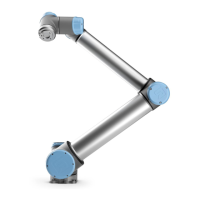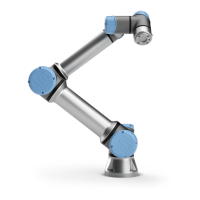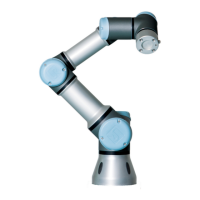13.1 Move Tab
When the robot TCP no longer is in the proximity of the limit, the 3D representation
disappears. If the TCP is in violation or very close to violating a boundary limit,
the visualization of the limit turns red.
13.1.2 Feature and Tool Position
In the top right corner of the screen, the feature selector can be found. It defines
which feature to control the robot arm relative to.
The name of the currently active Tool Center Point (TCP) is displayed below the
feature selector. The text boxes show the full coordinate values of that TCP relative
to the selected feature. For further information about configuring several named
TCPs, see 13.6.
Values can be edited manually by clicking on the coordinate or the joint position.
This will take you to the pose editor screen (see 12.2) where you can specify a target
position and orientation for the tool or target joint positions.
13.1.3 Move Tool
• Holding down a translate arrow (top) will move the tool-tip of the robot
in the direction indicated.
• Holding down a rotate arrow (bottom) will change the orientation of the
robot tool in the indicated direction. The point of rotation is the Tool Center
Point (TCP), i.e. the point at the end of the robot arm that gives a characteristic
point on the robot’s tool. The TCP is shown as a small blue ball.
Note: Release the button to stop the motion at any time!
13.1.4 Move Joints
Allows the individual joints to be controlled directly. Each joint can move from
−360
◦
to +360
◦
, which are the default joint limits illustrated by the horizontal bar
for each joint. If a joint reaches its joint limit, it cannot be driven any further. If
the limits for a joint have been configured with a position range different from the
default (see 10.11), this range is indicated with red in the horizontal bar.
13.1.5 Freedrive
While the Freedrive button is held down, it is possible to physically grab the robot
arm and pull it to where you want it to be. If the gravity setting (see 13.7) in the
Setup tab is wrong, or the robot arm carries a heavy load, the robot arm might
start moving (falling) when the Freedrive button is pressed. In that case, just release
the Freedrive button again.
CB3 II-36 Version 3.4.5
Copyright © 2009–2017 by Universal Robots A/S. All rights reserved.

